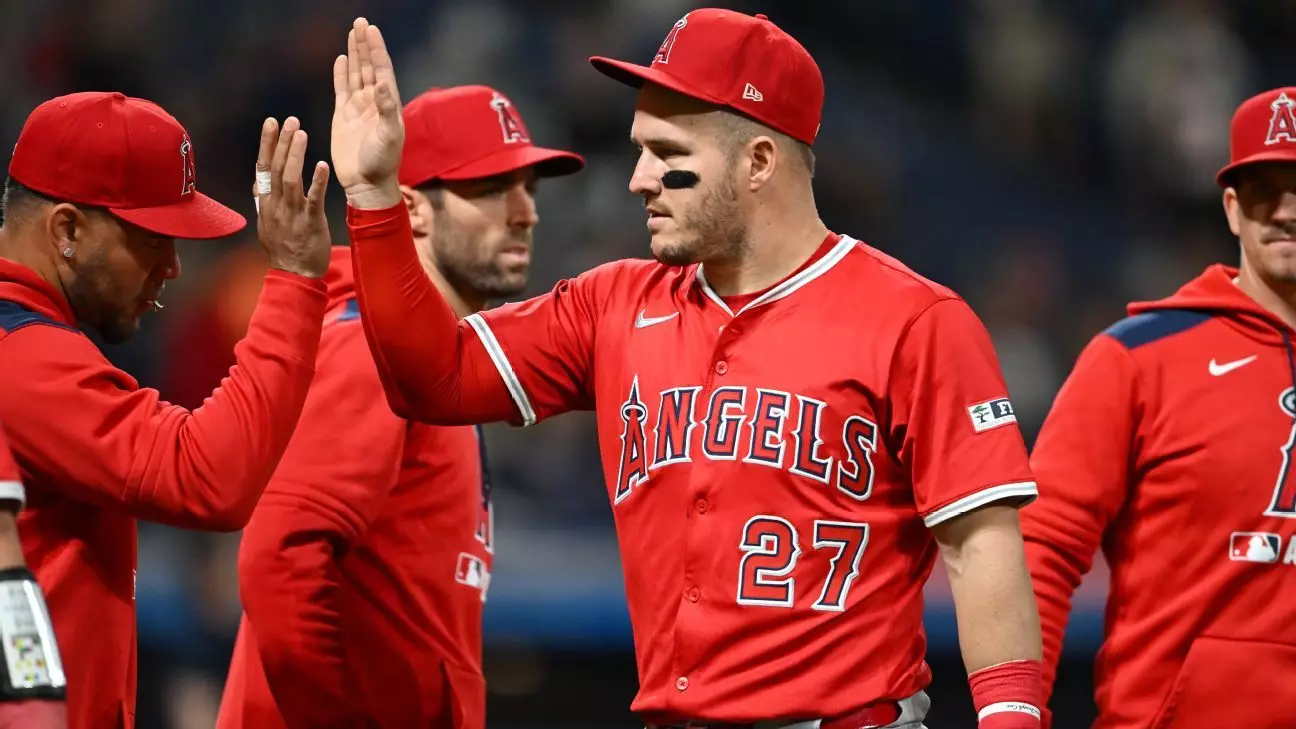In an intriguing turn of events, Mike Trout, the standout player for the Los Angeles Angels, made his highly anticipated return to the field earlier than many expected. Initially slated to come back during a series against the Boston Red Sox, Trout’s activation from the injured list occurred a few days earlier, marking a sudden shift that brought both excitement and hope to Angels fans. As the designated hitter against the Cleveland Guardians, Trout’s performance—where he went 1-for-5—sparked a sense of renewal for a team grappling with a difficult stretch. His return not only broke a five-game losing streak but also served as a reminder of Trout’s immense value and influence on the team’s morale.
The Journey Back from Injury
Trout’s comeback was particularly significant as it followed a challenging period of recovery after he missed 26 games due to a bone bruise in his left knee, a problem that stemmed from previous surgeries to repair his meniscus. Such repeated injuries incite concern—not just for Trout’s performance, but for the longevity of his career. The 33-year-old outfielder’s absence was palpable, considering he represents the heart of the organization. Through his injury-riddled history, which includes lengthy stints on the injured list over the last five seasons, there’s a haunting question lingering: can Trout reclaim his elite status consistently?
Despite being back on the roster, Trout’s statistics reflect the ongoing struggles typical for someone returning from injury. With a batting average lingering at .180 and a less-than-stellar OPS of .712, his offensive production requires evaluation. Trout’s first game back suggested optimism, showcasing his ability to make solid contact, but the road to full recovery appears long and daunting.
Managerial Decisions and Team Dynamics
Angels manager Ron Washington, acutely aware of the delicate nature of Trout’s situation, strategically placed him in the lineup batting fifth—a shift from his customary third spot. This decision wasn’t arbitrary; Washington expressed a desire to ease Trout back into the flow of the game, acknowledging that Trout hasn’t faced live pitching for some time. By placing him behind rookie Logan O’Hoppe, Washington aimed to alleviate the pressure on Trout while still maximizing his potential impact. This calculated approach highlights the need for careful management of Trout’s playing time and position as he transitions back into the sport.
Washington’s obvious relief at Trout’s return reflects not only the respect he commands as one of the game’s greats but also the collective sense of urgency surrounding the Angels’ season. With a record sitting at 26-30, Trout’s contributions are vital for a team vying for relevance in the competitive landscape of Major League Baseball. Washington’s statements about Trout’s performance underscore a deeper understanding: Trout’s presence can invigorate the team’s spirit and turn the tide, regardless of immediate statistics.
The Broader Implications for the Angels
TRouting back into the lineup represents more than just a temporary boost to the Angels’ offensive strategy; it symbolizes hope, resilience, and an embodiment of the franchise’s aspirations. For a player who has been described as the organization’s lifeblood, Trout’s durability—past the physical aspect—relates to the emotional energy he brings to both players and fans alike. His return could serve as a catalyst for improvement, especially as the stretch towards the All-Star break approaches.
Trout’s interaction with his teammates also provides insight into the culture within the Angels’ clubhouse. Young players like O’Hoppe recognize Trout’s veteran presence as a pivotal influence, citing his ability to uplift spirits during challenging times. The implications of Trout’s return extend beyond individual stats; it weaves a narrative of hope in a season that could quickly spiral without leadership and skilled gameplay.
The Future is Uncertain Yet Hopeful
Despite the initial thrill of his comeback, the uncertainty of Trout’s ongoing health looms large. His acknowledgement of the “tricky” nature of bone bruises paints a realistic picture of the future. Balancing his desire to perform with the need for careful rehabilitation remains a tightrope act for Trout and the Angels’ coaching staff. As they navigate this path, Trout’s identity as a player—one that directly influences the dynamics on the field—will have to adapt to accommodate his health.
What is clear is that a healthy Mike Trout revitalizes not only the Angels’ lineup but also the sport itself. His ability to draw fans into the stadium and change the course of games is irreplaceable. The thrill of watching Trout return isn’t just about statistics; it’s about witnessing a player who encapsulates the essence of baseball—a blend of perseverance, skill, and an unwavering passion for the game.


Leave a Reply